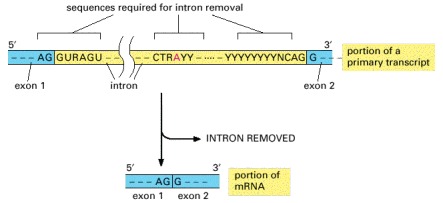From: From DNA to RNA

NCBI Bookshelf. A service of the National Library of Medicine, National Institutes of Health.

Only the three blocks of nucleotide sequences shown are required to remove an intron sequence; the rest of the intron can be occupied by any nucleotide. Here A, G, U, and C are the standard RNA nucleotides; R stands for either A or G; Y stands for either C or U. The A highlighted in red forms the branch point of the lariat produced by splicing. Only the GU at the start of the intron and the AG at its end are invariant nucleotides in the splicing consensus sequences. The remaining positions (even the branch point A) can be occupied by a variety of nucleotides, although the indicated nucleotides are preferred. The distances along the RNA between the three splicing consensus sequences are highly variable; however, the distance between the branch point and 3′ splice junction is typically much shorter than that between the 5′ splice junction and the branch point.
From: From DNA to RNA

NCBI Bookshelf. A service of the National Library of Medicine, National Institutes of Health.